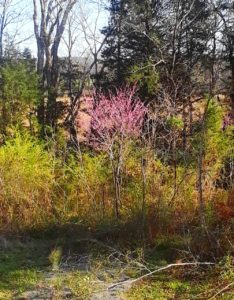Invasive privet (aka Chinese privet) is a non-native species throughout the Southeast USA. Privet crowds out native wildflowers, bushes and trees, and is difficult to remove. For example, when I moved to my property in Catoosa County, Northwest Georgia, nearly the entire edge of my woods was a solid mass of privet. Since removing it, however, more than 30 native trees, bushes and plants — including muscadine grapes, several species of oaks and hickory trees, redbuds, pawpaw, and many more have taken the invasive privets’ place.
Making Invasive Privet Removal Easier
Invasive privet is hard to manage. It spreads easily through seeds (via birds), AND even the smallest root left in the ground will sprout another plant. (Result? Just cutting it down really won’t be a long-term solution). Its long, intertwining taproot makes it hard to dig out of that baked Georgia clay in the summer. However, I’ve found a couple of tricks for removing this troublesome invasive plant pest:
- Remove privet in the fall, winter and early spring. Invasive privet keeps its glossy, green leaves throughout the year. When other, similar-looking native trees and bushes (possumhaw and Carolina buckthorn, for example) have dropped their leaves, privet stays green, making it easy to identify.
- Pull it out after a good rain. Invasive privet has a somewhat shallow root system. As you can see in this video, after a decent rain, small privet bushes come out fairly easily. Larger ones can be dug out with a shovel or pickax, especially after one of our Georgia rain storms!
Trust me, removing these pesky plants is well worth the effort, especially when you see the other native plants coming in and taking the invasive privets’ place! (Part of my inspiration for removing invasive privet and other non-native plants, and getting native trees, bushes, wildflowers and more to take their place comes from Doug Tallamy’s work: http://homegrownnationalpark.org/)

